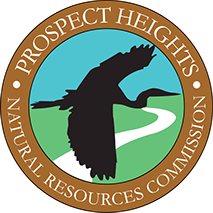Prospect Heights Natural Resources Commission
























Prospect Heights Slough
Location
North of Hillside Avenue, south of Willow Road, east of Elmhurst Road east of Marion/Maple Avenues. Located in Prospect Heights.
What
The Prospect Heights Slough is a naturally occurring wetland that has been here since the time of the glaciers retreat. The wetland shows up on the 1848 land survey map.
Size
13acres
History
The Prospect Heights Slough and what is called Hillcrest Lake were always one contiguous wetland until the 1950's when the farmer that owned the property, put a road in so he did not have to drive around to get to the other side. He was a dairy farmer that supplied milk to Chicago. The county officially made it a road, forever bisecting the two.
A homeowners association formed when the surrounding property was sold off for housing development and they decided to call it Hillcrest Lake. Eventually, the Hillcrest Homeowners Association sold the property to the city of Prospect Heights as the costs of maintenance started to mount. The two had been treated as separate entities ever since, with the Prospect Heights Park District owning a sizable portion of the Slough.
The Slough has had a tortured history of threats to fill it in, develop it, peat fires and derelict owners, only to be rescued time and time again by the People in the name of preserving nature. Click here to read historical records.
PHNRC restoration of the Slough began in 2014, with the first ComEd Green Regions grant. The funding was split between the Slough restoration and the start up of the ComEd prairie project. At the start, the entire wetland was encased in invasive buckthorn. It took volunteers two and a half years of working every other Sunday to free it. The greenhouse program has been the sole source of species used in restoration. That said, several great surprises emerged from the seed bank. Michigan lilies, tufted Loosestrife, Calamagrostis, and ___. Nine years in the making, prescribed burns, plantings, seeding and thousands of volunteer hours make it what you see today.
In 2021, the PHNRC and the Park District received their fourth ComEd Green Regions grant to install the 480 feet of boardwalk and reclaim over an acre of wetland back from the invasive cattails. The grant from ComEd was matched by the City and Park District of Prospect Heights, our most generous anonymous donor, Several community donations and the PHNRC Commissioners Fund. The project was also adopted by Eagle Scout Candidate, Felix Weirich. Over 20,000 native plugs from the NRC greenhouse were used in the reclamation and informational signage was also installed along the trails.
WHAT CAN YOU DO HERE:
This is the place for exploration, imagination, science, observation, exercise, the enjoyment of nature and fun!. The Slough has two sections of boardwalk that connect several nature trails and an observation deck. Depending on where you are on the trails, the landscape can change dramatically.
Walk or run the nature trails and boardwalks, explore the many different environments that surround the Slough, fish, observe wildlife, birds, turtles, snakes, insects and pollinators. Visit the Hyndman plum grove and have a plum in season or wait until winter and cross country ski, snowshoe, play hockey or ice-skate or observe the fall colors with a chill in the air.
WHAT CAN YOU SEE HERE:
Back in 2018, local birder Cyndi Lubecke released her species count of birds from the Slough that contained 98 species as of May of 2018. We are happy to say it is even higher today. It is a good indicator of the species that can be seen here when you take the migrations into account. Year round bird resident viewing is robust and just about any given day in spring, summer and fall you can see Egrets, Great blue herons, Osprey or the occasional Eagle fishing.
Birds
Turtles
Frogs
Snakes
Wildlife
Insects
Pollinators
Plants over 90 species of sedges, grasses, rushes, forbs and
Trails
Benches
Go fishing
Meditation class on boardwalk
Modular layout on the north boardwalk
ComEd Osprey pole
Fall color
Twlight
Start up trail conditions in the basin
Treading was a family affair
Treading was a family affair
Dusk on the boardwalk
Sunny day